SEO
What It Is + How to Succeed

Imagine all you needed to make money online was a website. You don’t have to create your own products or offer a service. Sounds good? Welcome to affiliate marketing.
According to Statista, business spending on affiliate marketing hit $8.2 billion in the U.S in 2022 and Influencer Marketing Hub estimates that the industry willl continue to grow to $15.7 billion by 2024.
Start today, and you’ll be in a prime position to take advantage of that.
https://www.youtube.com/watch?v=W-nbsnXtSZI
Affiliate marketing is where you promote another company’s product or service. When someone purchases through your affiliate link, you earn a commission. These commissions are usually a percentage of the sale price or a fixed amount.
Here are two reasons why you should consider doing affiliate marketing:
1. Low-cost and low-risk
Starting a business can be risky and expensive because there are upfront costs for products, employees, equipment, rent, etc. With affiliate marketing, all you need is a website. If it doesn’t work out, you’ve only wasted time and a little bit of money.
2. Easy to scale
A typical salesperson only sells products from one company. As an affiliate marketer, you can promote products from many different companies and earn commissions from all of them.
Learn more: How to Start Affiliate Marketing With No Money (5 Steps)
Upon joining an affiliate program, you get a unique link that contains a tracking ID. This allows the merchant to track if you’ve referred customers to them.
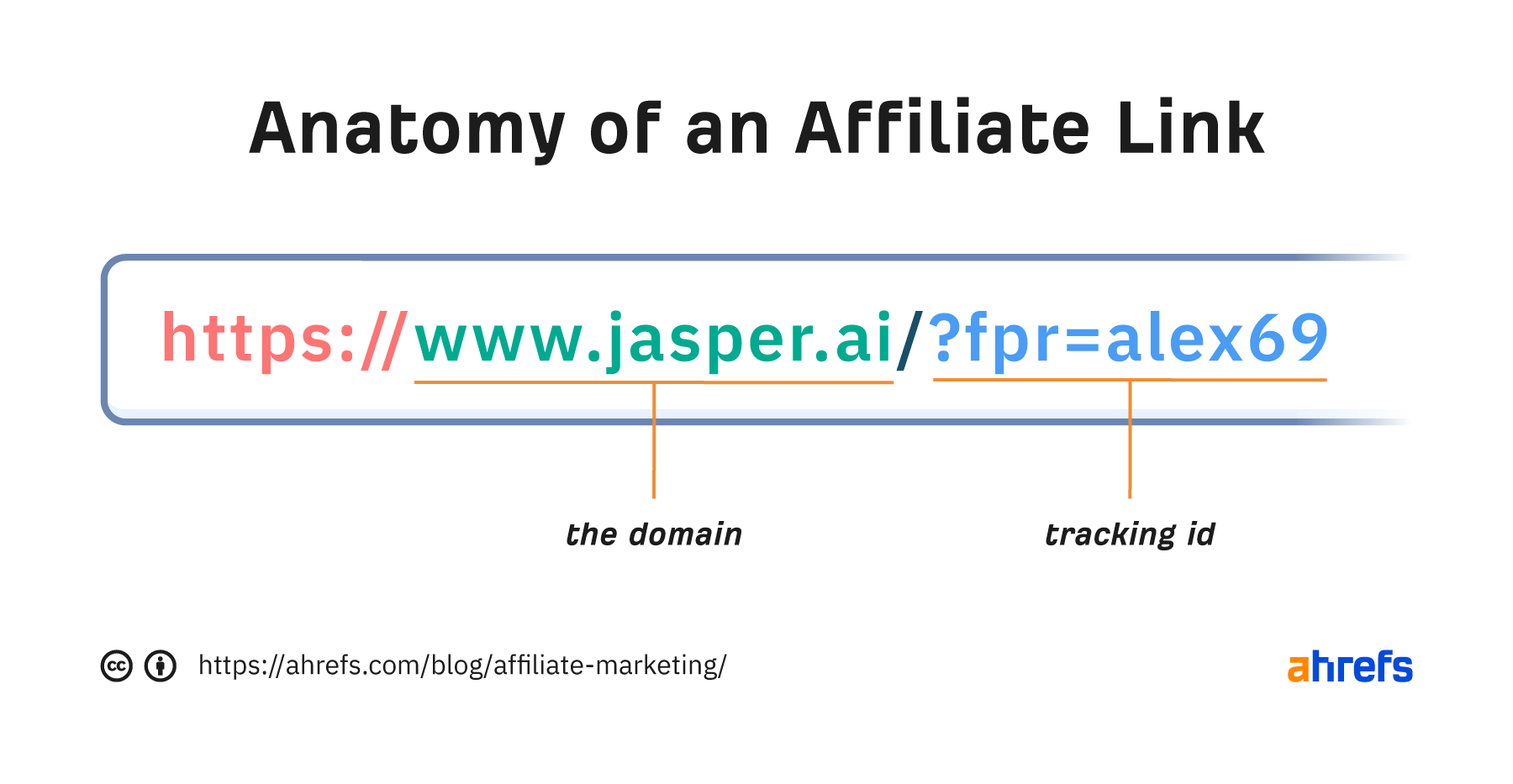
People who click on your link also get a tiny file called a cookie stored on their device. This (usually) holds an expiry date, so you get paid even if they delay buying for a while.
Here’s an example of how it works:
- Someone visits your post on the best winter jackets.
- They click the Amazon affiliate link for one of your recommendations.
- They close their browser to pick their kid up from school.
- They go back to Amazon the next day to check out the product again.
- They buy the recommended product, along with some ski gear.
Thanks to the affiliate cookie stored on this person’s device, you earn a commission on the recommended product and the ski gear.
Most affiliate marketers earn less than $10K per year. That’s according to a survey from Influencer Marketing Hub.
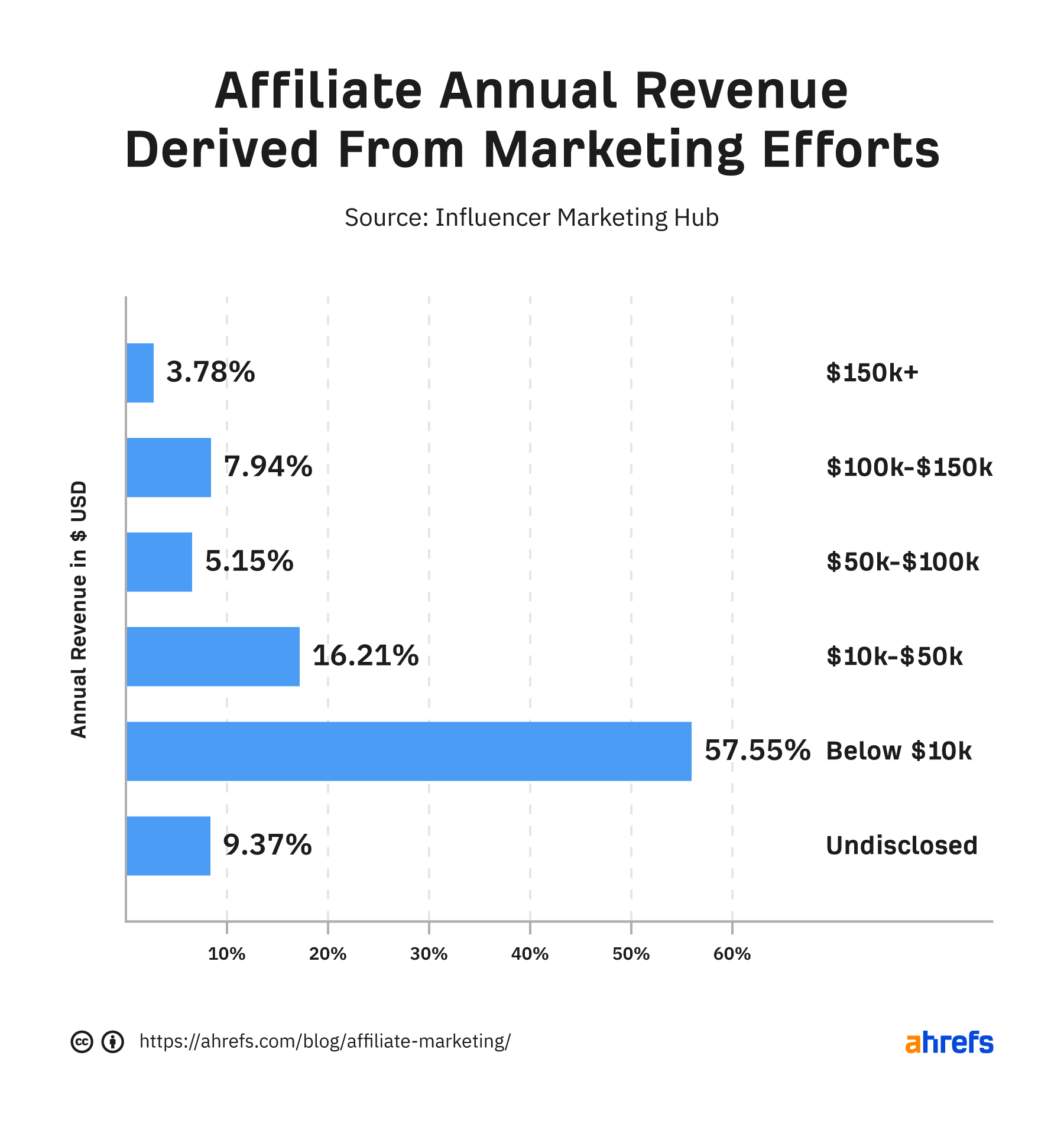
Yet, roughly one in six (16.87%) make $50k per year or more.
Matt Giovanisci is a good example of a high-earning affiliate. His site, Swim University, made $149,991 affiliate commissions in 2021.
Keep in mind though that these people have done an excellent job building their brand. It’s taken them years of hard work to reach this level.
If you’re just starting out, your checks might look more like this for a while:
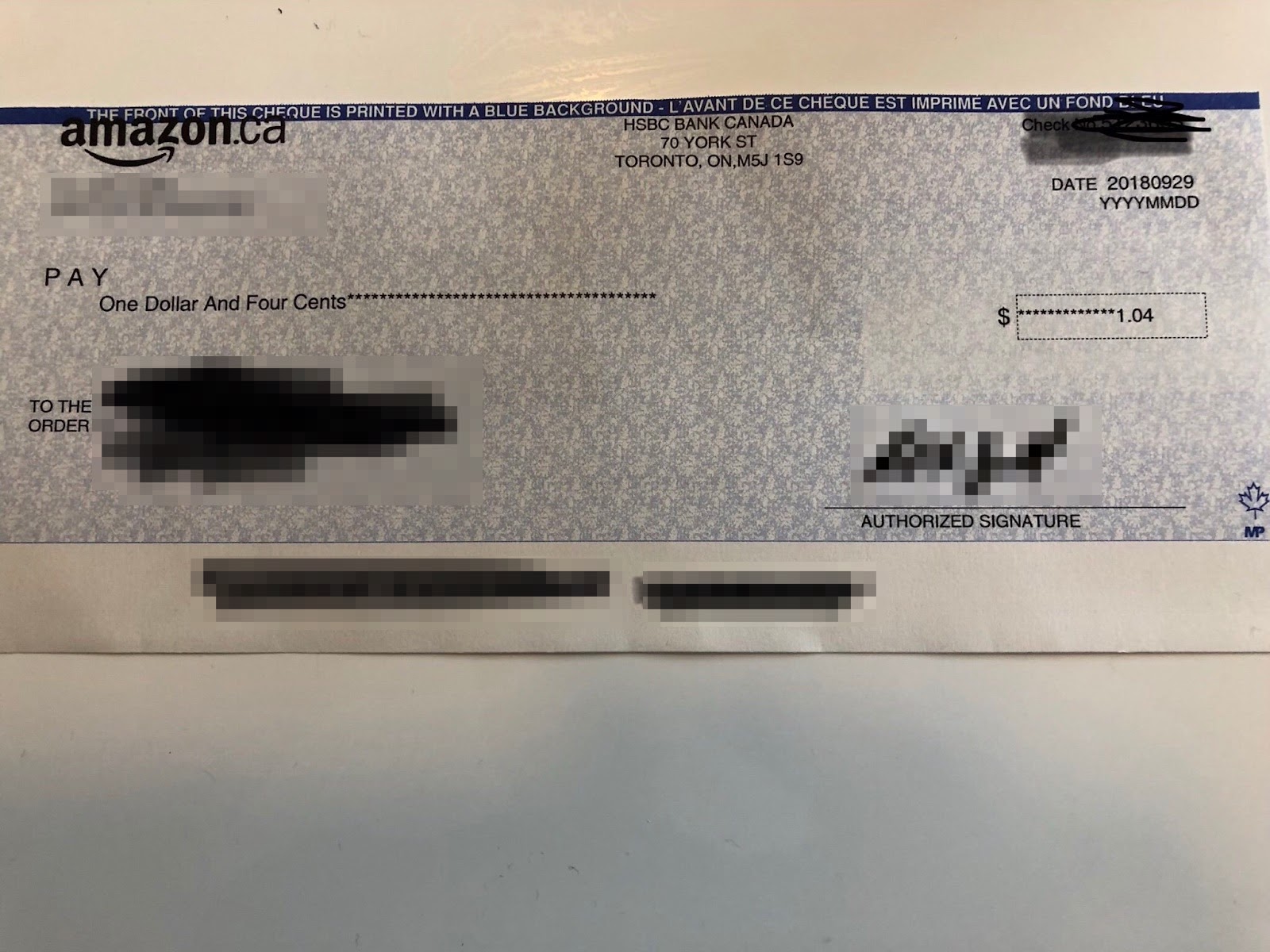
You need to manage your expectations. You won’t earn the big bucks right off the bat, but don’t let this discourage you.
The success of others tells you that with hard work, time, and the right knowledge, you too can potentially reach those levels.
Learn more: Here’s How Much You Can Really Make From Affiliate Marketing
Follow these seven simple steps:
Step 1: Choose your niche
Your niche is the category you want to talk about and promote.
To stand out amongst the countless other websites today, my advice is to be specific. Instead of tackling a broad niche like food, go for something a bit narrower, like grilling. This helps you build a more focused audience and may also help with SEO.
Here are four questions to ask yourself to find a good niche:
- What am I good at?
- What do I like doing?
- What am I curious about?
- What do other people tell me I’m good at?
It’s hard to overstate the importance of choosing something you’re passionate about. You’ll need to create a lot of content to succeed with affiliate marketing. If you choose something you hate, you’ll find it hard to press on when the going gets tough.
That’s why, when I built my first site, I chose to talk about one of my hobbies—breakdancing. And despite knowing nothing about marketing, I grew it to an estimated 2K monthly visits.
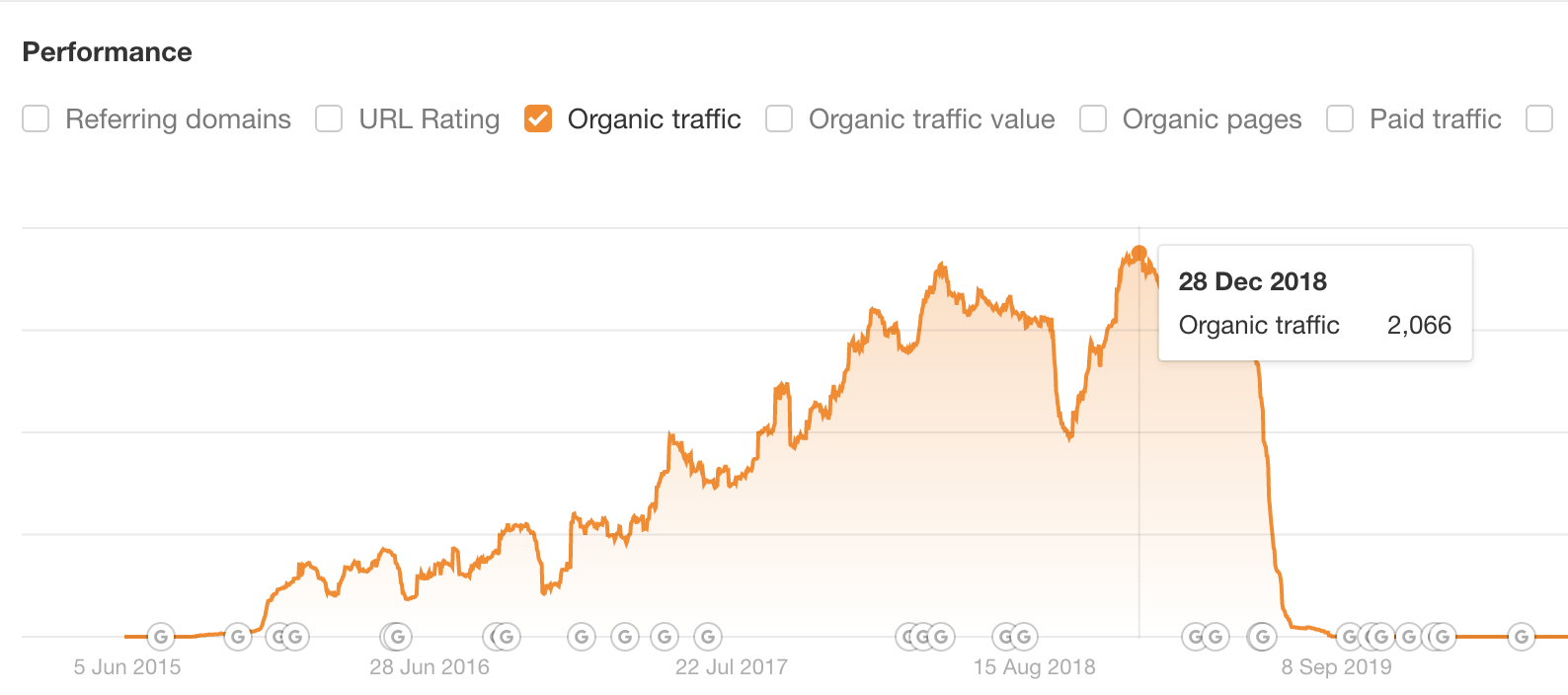
Learn more: How to Easily Find a Niche for Affiliate Marketing
Step 2: Decide on a content platform
You can do affiliate marketing on any platform. This includes:
- Website
- YouTube
- Social media (e.g., Instagram, TikTok)
- Newsletter
- Podcast
The method you choose will depend on your preference and occasionally, your niche’s preference. For example, people who are learning breakdance will prefer videos. So, even if you prefer writing, running a YouTube channel may be a better option.
That being said, we recommend building a website and using search engine optimization (SEO) to rank your content high on Google. This allows us to generate passive search traffic consistently, which means consistent clicks on affiliate links too.
TIP
Whether you’re creating a website, YouTube, or something else, note that you’ll need to disclose the fact that you’re including affiliate links. The Federal Trade Commission (FTC) requires you to be transparent when receiving income from an endorsement.
If you’re building a website, create a standalone page or include it in the footer of your website:

If you’re doing it on YouTube, include it in your description:

Step 3: Find affiliate programs to join
There are three main types of affiliate programs to choose from:
- High-paying, low-volume — Niche products with fewer buyers. For example, HubSpot sells only to businesses but their affiliate program pays well (100% of first month and 15% monthly recurring commission.)
- Low-paying, high-volume — Products with mass appeal, e.g. PS5 games. For example, Amazon only pays up to 10% commission. But the good thing is they offer commissions off the entire value of the purchase (and not just the product you recommended.)
- High-paying, high-volume — Expensive products with mass appeal, e.g. credit cards. An issue is that these programs tend to attract affiliate marketers with deep expertise and pockets and willingness to black-hat tactics.
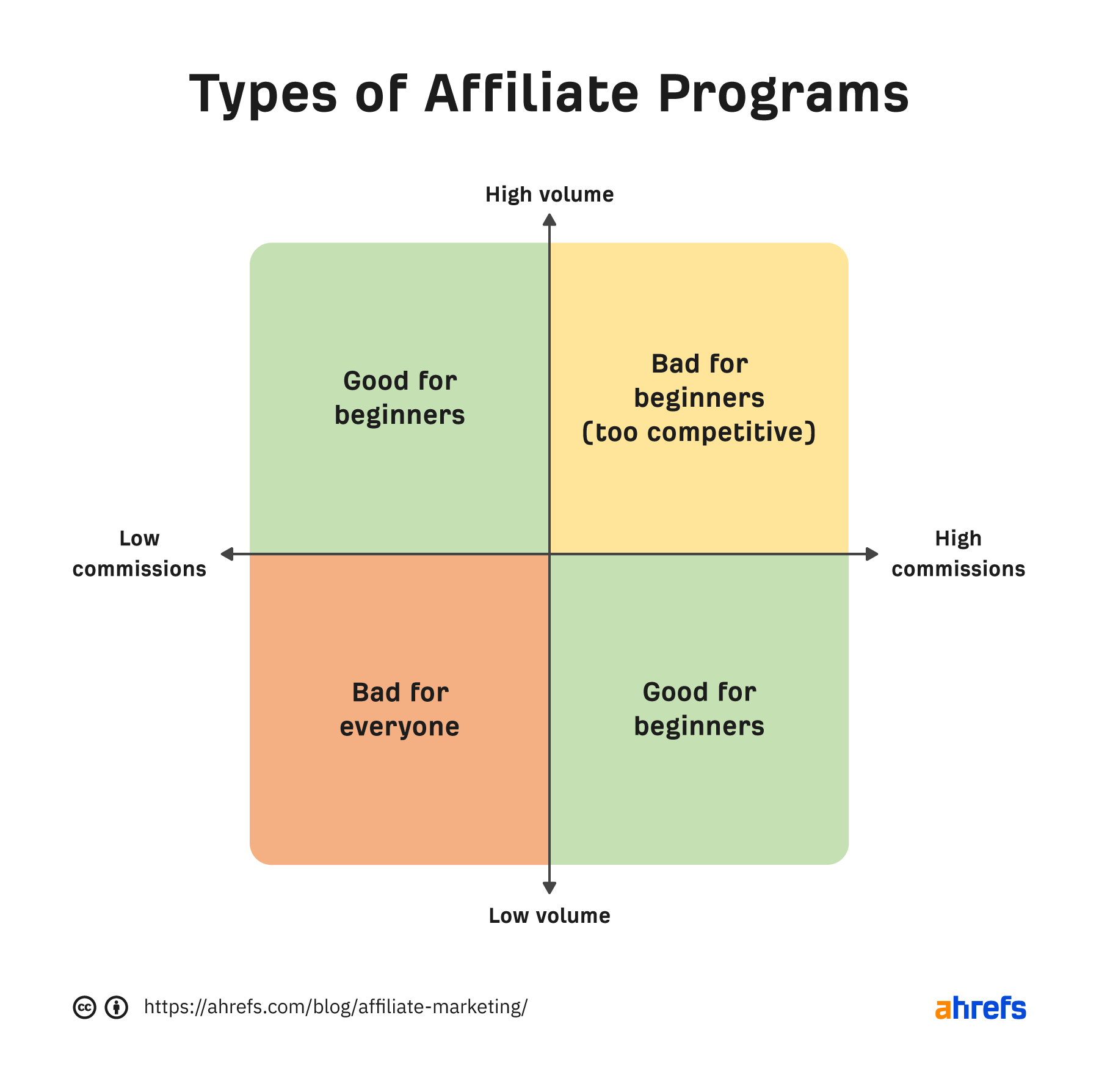
Which affiliate program should you join? This depends on your niche and level of expertise.
If you’re targeting consumers, go with the second model: low-paying, high-volume. If you’re targeting businesses, go for the first one: high-paying, low-volume. Popular programs include software and web hosting-related products.
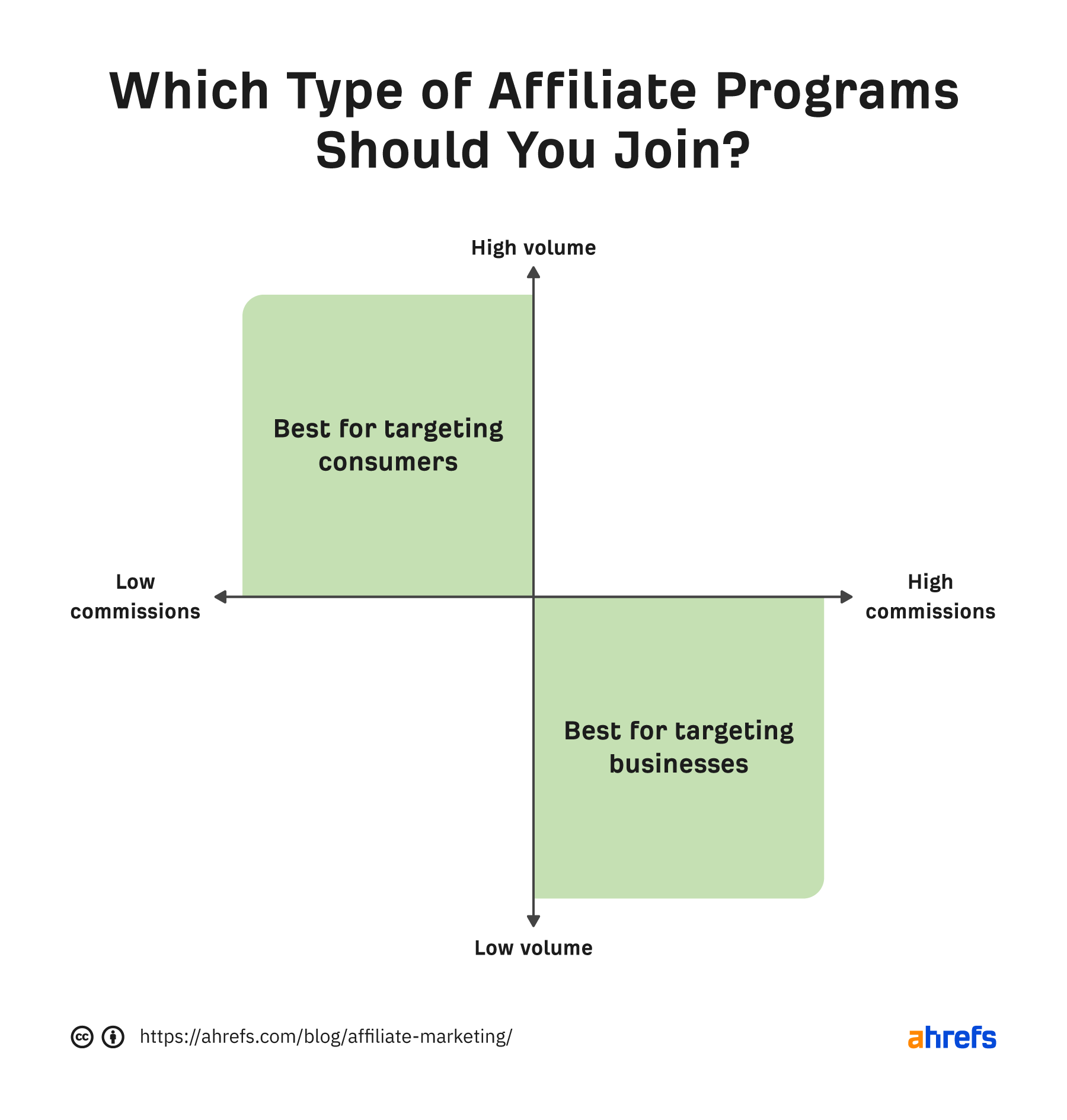
The best way to find these affiliate programs is with a Google search. Alternatively, enter a competing affiliate site into Ahrefs’ Site Explorer and go to the Linked domains report.
For example, I know that Pat Flynn promotes a number of software products on his website, Smart Passive Income. Eyeballing the report shows that Pat links to Aweber pretty often. And if we expand the caret, we’ll see that Pat is an affiliate.

It only takes a quick Google search to find an application form for this program.
If there is a product you’d like to promote but they don’t have a public affiliate program, reach out to the company and ask if they would be willing to build an affiliate relationship with you.
Learn more: 9 Best Affiliate Programs for Beginners (Any Niche)
Step 4: Create great content
If you want your affiliate site to succeed, you need to create high-quality content where your affiliate links fit naturally.Don’t just blindly curate products from Amazon’s best sellers. Go the extra mile and make sure your content solves your readers’ problems.
For example, if you’re doing reviews, you should actually purchase the product and test it. Use it over a period of time and report your findings.
That’s what Wirecutter did for all their articles, which explains their success. For example, in order to find the best air purifiers, they tested more than 50 of them:

If you can collaborate with experts to review your findings, that’s even better. Again, Wirecutter goes above and beyond in this aspect, solidifying their status as the gold standard of affiliate websites:

Step 5: Drive traffic to your affiliate site
You’ve created great content. The next step is to get more people to read it, so they will click on your affiliate links.
Here are three traffic strategies to consider:
A. Paid traffic
This is where you pay for traffic to your site. You can do this using pay-per-click (PPC) ads.
The advantage of paid traffic is that the moment you start paying, you get traffic.
However, there are some downsides.
First, running ads will dig into your profits. It’s quite normal for advertisers to lose money before they make it… if they ever do.
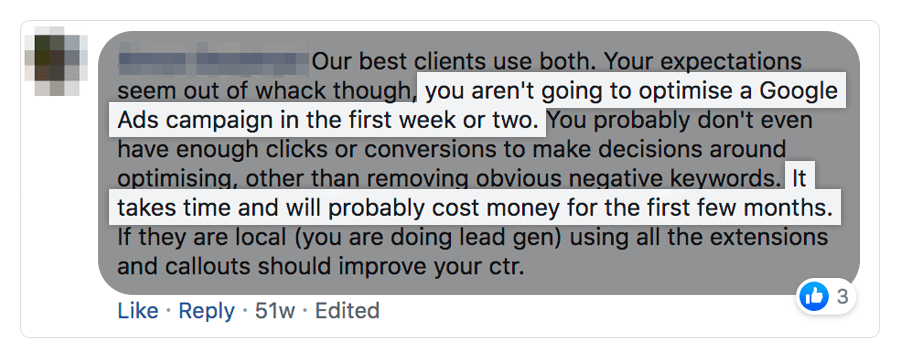
You need to be realistic about how long it takes to optimize a paid traffic campaign.
Secondly, once you stop paying for ads, your traffic will stop.
Generally speaking, ads are a great traffic strategy if you’re part of a high-paying affiliate program and can make the numbers work.
But if you’re completely new to paid marketing and have no marketing budget (or are working with lower commission programs like Amazon Associates), then it might not be such a great idea.
Learn more: PPC Marketing: Beginner’s Guide to Pay-Per-Click Ads
B. SEO
SEO is the practice of optimizing pages to rank high in search engines like Google.
For as long as you can rank high in the search engines for your target keywords, you’ll get consistent and passive traffic.
On the most basic level, SEO is about:
- Understanding what your target customers are searching for
- Creating content around those topics
- Making sure Google understands clearly what your page is about
- Acquiring or earning links to push your pages higher in the search engines
- Ensuring Google can find, crawl, and index your content
Learn the basics in this video or read our beginner’s guide to SEO:
https://www.youtube.com/watch?v=DvwS7cV9GmQ
C. Build an email list
Email lists allow you to communicate with your readers anytime.
Use them to tell fans about new content and keep them coming back to your site for more. This leads to more affiliate clicks and sales.
You can even add affiliate links in the emails to your audience:

To build an email list, you need to persuade the readers on your site to sign up. That means offering something valuable, like a free eBook, an email course, and more.
Step 6: Get clicks on your affiliate links
Just because you have an amazing piece of content doesn’t mean people will click on your affiliate links.
There are a few things you need to consider.
A. Link placement
If all your affiliate links are at the bottom of the page where people rarely scroll, clicks will be few and far between.
On the other hand, make every other word a link in your introduction, and your content will look spammy.
You need to balance link placement with the other factors below.
B. Context
Let’s say you were writing an article on the best kitchen knives for under $50.
Your introduction probably shouldn’t look like this:
The links look out of context and spammy.
This would make more sense:
Today, I’m reviewing three different chef knives you can buy on Amazon for under $50. These are, product name 1, product name 2, and product name 3
C. Callouts
Using callouts like buttons, tables, and boxes can help attract your readers attention and make the post more skimmable.
For example, the Wirecutter uses eye-catching boxes with product links anytime they share a top pick.
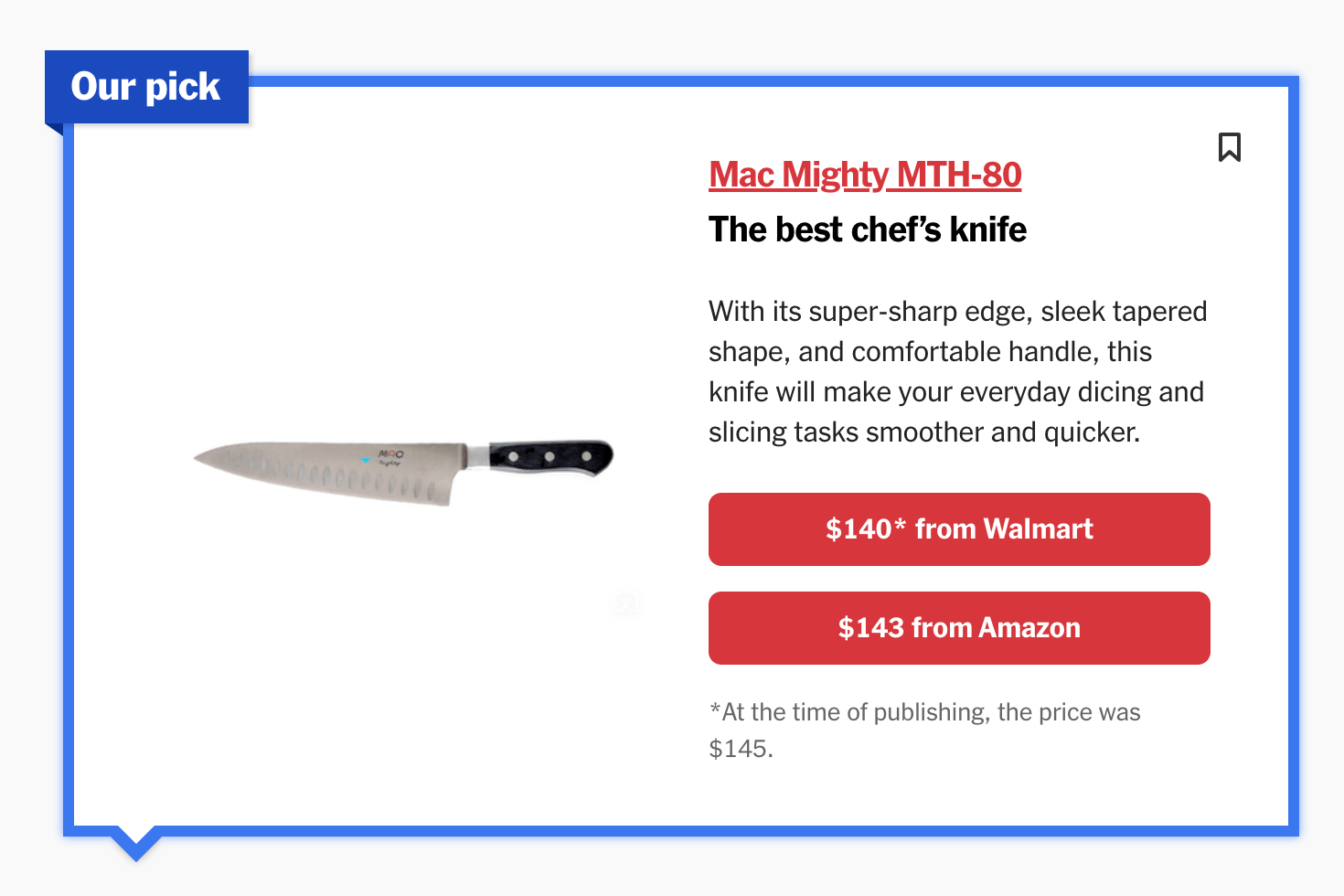
Good Housekeeping takes a different approach and creates a table with buttons:

Step 7: Convert clicks to sales
In affiliate marketing, two conversions need to take place for you to make money.
The first conversion is the click to the product page.
You’re 100% in control of this action. Use the tactics above to improve your chances of getting that click.
The second conversion is the visitor purchasing the product. In the case of affiliate marketing, the merchant controls the checkout, and their conversion rates are out of your control.
The trick is to play the game to your advantage and look for merchants with programs that convert well.
Here are a few ways to find them:
A. Public income reports
If people are making decent money from an affiliate program, then it’s likely that the product converts well.
How do you know if people are making money?
Look at public income reports where bloggers publicly reveal how much money they’re making from their affiliate deals.
You can find these reports on Google.
For example, if you search for “income report amazon affiliate”, you’ll see a few blog posts showing how bloggers have made money from Amazon Affiliates.

Looks like one blogger made over $47,000 from Amazon Associates:

If you’re in the same space, you can also take a look at where her other affiliate income comes from, and potentially promote the same products.
B. Ask questions
If there isn’t much information available about an affiliate program you want to join, sign up and ask questions.
For example, you might want to find out what their average conversion rates are, or a ballpark figure of their top earners’ monthly commissions.
This can help you figure out if the affiliate program is worth promoting.
C. Use your intuition
Sometimes, it’s best to go with your gut feeling.
If the program or product you’re checking out feels “off, or if you would personally never recommend the product to a friend or family member, then don’t promote it.
Tools are your friends in affiliate marketing. They help you do your job faster and easier.
Here are some of our recommended affiliate marketing tools:
- Ahrefs — All-in-one SEO tool that’ll help you research keywords to target, audit your website, research your competitors, find content ideas, and more.
- Rank Math — WordPress plugin that ensures your pages have optimal on-page SEO.
- Google Search Console — Find and fix technical errors on your website, submit sitemaps, see structured data issues, check your Core Web Vitals, and more.
- Google Analytics — Provides crucial data and analytics for your affiliate website.
- Thirsty Affiliates — Keep track of your affiliate links, see statistics to know which links are getting the most clicks, and prevent others from easily copying your website and swapping the links with their own affiliate IDs.
Learn more: 15 Best Affiliate Marketing Tools & How to Use Them
Final thoughts
No affiliate marketing wheels were reinvented here. These are the fundamentals, and applying them will get you off on the right foot.
Just don’t expect life-changing income or the freedom to quit your 9-5 overnight. Affiliate marketing takes time.
Focus first on making your first affiliate sale. As your site grows, set new goals, and continue experimenting.
This is how to build up a site that eventually generates a decent income.
Got questions? Ping me on Twitter.
SEO
How To Write ChatGPT Prompts To Get The Best Results

ChatGPT is a game changer in the field of SEO. This powerful language model can generate human-like content, making it an invaluable tool for SEO professionals.
However, the prompts you provide largely determine the quality of the output.
To unlock the full potential of ChatGPT and create content that resonates with your audience and search engines, writing effective prompts is crucial.
In this comprehensive guide, we’ll explore the art of writing prompts for ChatGPT, covering everything from basic techniques to advanced strategies for layering prompts and generating high-quality, SEO-friendly content.
Writing Prompts For ChatGPT
What Is A ChatGPT Prompt?
A ChatGPT prompt is an instruction or discussion topic a user provides for the ChatGPT AI model to respond to.
The prompt can be a question, statement, or any other stimulus to spark creativity, reflection, or engagement.
Users can use the prompt to generate ideas, share their thoughts, or start a conversation.
ChatGPT prompts are designed to be open-ended and can be customized based on the user’s preferences and interests.
How To Write Prompts For ChatGPT
Start by giving ChatGPT a writing prompt, such as, “Write a short story about a person who discovers they have a superpower.”
ChatGPT will then generate a response based on your prompt. Depending on the prompt’s complexity and the level of detail you requested, the answer may be a few sentences or several paragraphs long.
Use the ChatGPT-generated response as a starting point for your writing. You can take the ideas and concepts presented in the answer and expand upon them, adding your own unique spin to the story.
If you want to generate additional ideas, try asking ChatGPT follow-up questions related to your original prompt.
For example, you could ask, “What challenges might the person face in exploring their newfound superpower?” Or, “How might the person’s relationships with others be affected by their superpower?”
Remember that ChatGPT’s answers are generated by artificial intelligence and may not always be perfect or exactly what you want.
However, they can still be a great source of inspiration and help you start writing.
Must-Have GPTs Assistant
I recommend installing the WebBrowser Assistant created by the OpenAI Team. This tool allows you to add relevant Bing results to your ChatGPT prompts.
This assistant adds the first web results to your ChatGPT prompts for more accurate and up-to-date conversations.
It is very easy to install in only two clicks. (Click on Start Chat.)
For example, if I ask, “Who is Vincent Terrasi?,” ChatGPT has no answer.
With WebBrower Assistant, the assistant creates a new prompt with the first Bing results, and now ChatGPT knows who Vincent Terrasi is.
 Screenshot from ChatGPT, March 2023
Screenshot from ChatGPT, March 2023You can test other GPT assistants available in the GPTs search engine if you want to use Google results.
Master Reverse Prompt Engineering
ChatGPT can be an excellent tool for reverse engineering prompts because it generates natural and engaging responses to any given input.
By analyzing the prompts generated by ChatGPT, it is possible to gain insight into the model’s underlying thought processes and decision-making strategies.
One key benefit of using ChatGPT to reverse engineer prompts is that the model is highly transparent in its decision-making.
This means that the reasoning and logic behind each response can be traced, making it easier to understand how the model arrives at its conclusions.
Once you’ve done this a few times for different types of content, you’ll gain insight into crafting more effective prompts.
Prepare Your ChatGPT For Generating Prompts
First, activate the reverse prompt engineering.
- Type the following prompt: “Enable Reverse Prompt Engineering? By Reverse Prompt Engineering I mean creating a prompt from a given text.”
 Screenshot from ChatGPT, March 2023
Screenshot from ChatGPT, March 2023ChatGPT is now ready to generate your prompt. You can test the product description in a new chatbot session and evaluate the generated prompt.
- Type: “Create a very technical reverse prompt engineering template for a product description about iPhone 11.”
 Screenshot from ChatGPT, March 2023
Screenshot from ChatGPT, March 2023The result is amazing. You can test with a full text that you want to reproduce. Here is an example of a prompt for selling a Kindle on Amazon.
- Type: “Reverse Prompt engineer the following {product), capture the writing style and the length of the text :
product =”
 Screenshot from ChatGPT, March 2023
Screenshot from ChatGPT, March 2023I tested it on an SEJ blog post. Enjoy the analysis – it is excellent.
- Type: “Reverse Prompt engineer the following {text}, capture the tone and writing style of the {text} to include in the prompt :
text = all text coming from https://www.searchenginejournal.com/google-bard-training-data/478941/”
 Screenshot from ChatGPT, March 2023
Screenshot from ChatGPT, March 2023But be careful not to use ChatGPT to generate your texts. It is just a personal assistant.
Go Deeper
Prompts and examples for SEO:
- Keyword research and content ideas prompt: “Provide a list of 20 long-tail keyword ideas related to ‘local SEO strategies’ along with brief content topic descriptions for each keyword.”
- Optimizing content for featured snippets prompt: “Write a 40-50 word paragraph optimized for the query ‘what is the featured snippet in Google search’ that could potentially earn the featured snippet.”
- Creating meta descriptions prompt: “Draft a compelling meta description for the following blog post title: ’10 Technical SEO Factors You Can’t Ignore in 2024′.”
Important Considerations:
- Always Fact-Check: While ChatGPT can be a helpful tool, it’s crucial to remember that it may generate inaccurate or fabricated information. Always verify any facts, statistics, or quotes generated by ChatGPT before incorporating them into your content.
- Maintain Control and Creativity: Use ChatGPT as a tool to assist your writing, not replace it. Don’t rely on it to do your thinking or create content from scratch. Your unique perspective and creativity are essential for producing high-quality, engaging content.
- Iteration is Key: Refine and revise the outputs generated by ChatGPT to ensure they align with your voice, style, and intended message.
Additional Prompts for Rewording and SEO:
– Rewrite this sentence to be more concise and impactful.
– Suggest alternative phrasing for this section to improve clarity.
– Identify opportunities to incorporate relevant internal and external links.
– Analyze the keyword density and suggest improvements for better SEO.
Remember, while ChatGPT can be a valuable tool, it’s essential to use it responsibly and maintain control over your content creation process.
Experiment And Refine Your Prompting Techniques
Writing effective prompts for ChatGPT is an essential skill for any SEO professional who wants to harness the power of AI-generated content.
Hopefully, the insights and examples shared in this article can inspire you and help guide you to crafting stronger prompts that yield high-quality content.
Remember to experiment with layering prompts, iterating on the output, and continually refining your prompting techniques.
This will help you stay ahead of the curve in the ever-changing world of SEO.
More resources:
Featured Image: Tapati Rinchumrus/Shutterstock
SEO
Measuring Content Impact Across The Customer Journey

Understanding the impact of your content at every touchpoint of the customer journey is essential – but that’s easier said than done. From attracting potential leads to nurturing them into loyal customers, there are many touchpoints to look into.
So how do you identify and take advantage of these opportunities for growth?
Watch this on-demand webinar and learn a comprehensive approach for measuring the value of your content initiatives, so you can optimize resource allocation for maximum impact.
You’ll learn:
- Fresh methods for measuring your content’s impact.
- Fascinating insights using first-touch attribution, and how it differs from the usual last-touch perspective.
- Ways to persuade decision-makers to invest in more content by showcasing its value convincingly.
With Bill Franklin and Oliver Tani of DAC Group, we unravel the nuances of attribution modeling, emphasizing the significance of layering first-touch and last-touch attribution within your measurement strategy.
Check out these insights to help you craft compelling content tailored to each stage, using an approach rooted in first-hand experience to ensure your content resonates.
Whether you’re a seasoned marketer or new to content measurement, this webinar promises valuable insights and actionable tactics to elevate your SEO game and optimize your content initiatives for success.
View the slides below or check out the full webinar for all the details.
SEO
How to Find and Use Competitor Keywords

Competitor keywords are the keywords your rivals rank for in Google’s search results. They may rank organically or pay for Google Ads to rank in the paid results.
Knowing your competitors’ keywords is the easiest form of keyword research. If your competitors rank for or target particular keywords, it might be worth it for you to target them, too.
There is no way to see your competitors’ keywords without a tool like Ahrefs, which has a database of keywords and the sites that rank for them. As far as we know, Ahrefs has the biggest database of these keywords.
How to find all the keywords your competitor ranks for
- Go to Ahrefs’ Site Explorer
- Enter your competitor’s domain
- Go to the Organic keywords report
The report is sorted by traffic to show you the keywords sending your competitor the most visits. For example, Mailchimp gets most of its organic traffic from the keyword “mailchimp.”


Since you’re unlikely to rank for your competitor’s brand, you might want to exclude branded keywords from the report. You can do this by adding a Keyword > Doesn’t contain filter. In this example, we’ll filter out keywords containing “mailchimp” or any potential misspellings:


If you’re a new brand competing with one that’s established, you might also want to look for popular low-difficulty keywords. You can do this by setting the Volume filter to a minimum of 500 and the KD filter to a maximum of 10.


How to find keywords your competitor ranks for, but you don’t
- Go to Competitive Analysis
- Enter your domain in the This target doesn’t rank for section
- Enter your competitor’s domain in the But these competitors do section


Hit “Show keyword opportunities,” and you’ll see all the keywords your competitor ranks for, but you don’t.


You can also add a Volume and KD filter to find popular, low-difficulty keywords in this report.


How to find keywords multiple competitors rank for, but you don’t
- Go to Competitive Analysis
- Enter your domain in the This target doesn’t rank for section
- Enter the domains of multiple competitors in the But these competitors do section


You’ll see all the keywords that at least one of these competitors ranks for, but you don’t.


You can also narrow the list down to keywords that all competitors rank for. Click on the Competitors’ positions filter and choose All 3 competitors:


- Go to Ahrefs’ Site Explorer
- Enter your competitor’s domain
- Go to the Paid keywords report


This report shows you the keywords your competitors are targeting via Google Ads.
Since your competitor is paying for traffic from these keywords, it may indicate that they’re profitable for them—and could be for you, too.
You know what keywords your competitors are ranking for or bidding on. But what do you do with them? There are basically three options.
1. Create pages to target these keywords
You can only rank for keywords if you have content about them. So, the most straightforward thing you can do for competitors’ keywords you want to rank for is to create pages to target them.
However, before you do this, it’s worth clustering your competitor’s keywords by Parent Topic. This will group keywords that mean the same or similar things so you can target them all with one page.
Here’s how to do that:
- Export your competitor’s keywords, either from the Organic Keywords or Content Gap report
- Paste them into Keywords Explorer
- Click the “Clusters by Parent Topic” tab


For example, MailChimp ranks for keywords like “what is digital marketing” and “digital marketing definition.” These and many others get clustered under the Parent Topic of “digital marketing” because people searching for them are all looking for the same thing: a definition of digital marketing. You only need to create one page to potentially rank for all these keywords.


2. Optimize existing content by filling subtopics
You don’t always need to create new content to rank for competitors’ keywords. Sometimes, you can optimize the content you already have to rank for them.
How do you know which keywords you can do this for? Try this:
- Export your competitor’s keywords
- Paste them into Keywords Explorer
- Click the “Clusters by Parent Topic” tab
- Look for Parent Topics you already have content about
For example, if we analyze our competitor, we can see that seven keywords they rank for fall under the Parent Topic of “press release template.”


If we search our site, we see that we already have a page about this topic.


If we click the caret and check the keywords in the cluster, we see keywords like “press release example” and “press release format.”


To rank for the keywords in the cluster, we can probably optimize the page we already have by adding sections about the subtopics of “press release examples” and “press release format.”
3. Target these keywords with Google Ads
Paid keywords are the simplest—look through the report and see if there are any relevant keywords you might want to target, too.
For example, Mailchimp is bidding for the keyword “how to create a newsletter.”


If you’re ConvertKit, you may also want to target this keyword since it’s relevant.
If you decide to target the same keyword via Google Ads, you can hover over the magnifying glass to see the ads your competitor is using.


You can also see the landing page your competitor directs ad traffic to under the URL column.


Learn more
Check out more tutorials on how to do competitor keyword analysis:
-

 PPC5 days ago
PPC5 days ago19 Best SEO Tools in 2024 (For Every Use Case)
-
SEARCHENGINES7 days ago
Daily Search Forum Recap: April 17, 2024
-

 SEO7 days ago
SEO7 days agoAn In-Depth Guide And Best Practices For Mobile SEO
-
SEARCHENGINES6 days ago
Daily Search Forum Recap: April 18, 2024
-

 MARKETING6 days ago
MARKETING6 days agoEcommerce evolution: Blurring the lines between B2B and B2C
-
SEARCHENGINES5 days ago
Daily Search Forum Recap: April 19, 2024
-

 SEO6 days ago
SEO6 days ago2024 WordPress Vulnerability Report Shows Errors Sites Keep Making
-

 WORDPRESS5 days ago
WORDPRESS5 days agoHow to Make $5000 of Passive Income Every Month in WordPress














